Alumni, Broadcom MASTERS, ISEF
Society alumni honored in Popular Mechanics
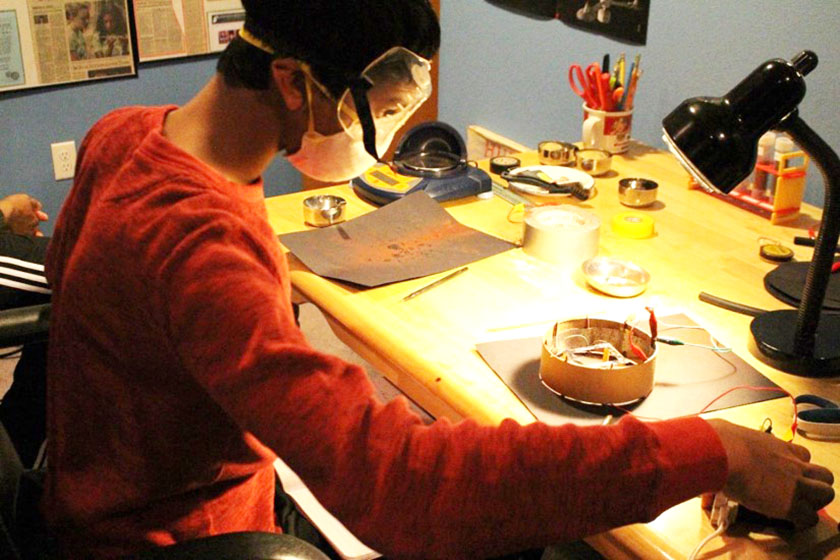
Seven Society for Science & the Public alumni were recently Popular Mechanics magazine’s Next Generation: Future Breakthrough awardees. The magazine described their projects and inspirations. Here are the Society alumni who were featured:
- Margaret Cirino, a junior in high school, plans to study engineering in the future. She was an Intel ISEF 2015 finalist and a Broadcom MASTERS 2013 semifinalist.
- Ashwin Datta, a junior in high school, was an Intel ISEF 2015 finalist.
- Kelly Devens, a senior in high school, was an Intel ISEF 2014 and 2015 finalist. She is interested in majoring in biomechanical engineering. She wants to develop orthotic devices for mobility-impaired humans and animals.
- Mihir Garimella, a junior in high school, was a multi-year Broadcom MASTERS semifinalist, a 2013 finalist and an Intel ISEF 2015 finalist. He participates in hackathons to develop apps like HeadsUp or Classroom. Mihir has spoken at TEDxTeen in New York, presented technical research at Johns Hopkins University, and showed his work to Google’s Project Wing team.
- Olivia Hallisey, a junior in high school, was an Intel ISEF 2015 finalist.
- Deena Mousa, a senior in high school, was an Intel ISEF 2013 and 2015 finalist. She interns at the Rensselaer Polytechnic Institute in the Materials Science and Engineering department, studying ways to improve the efficacy of solar panels. She is the president of her school’s Science Olympiad team.
- Maya Varma, a senior in high school, was a Broadcom MASTERS 2011 and 2012 semifinalist and an Intel ISEF 2015 finalist. She is the captain of her FIRST Tech Challenge robotics team and president of her school’s Women in Computer Science Club. Maya is a bioinformatics research intern at Stanford Medical School.
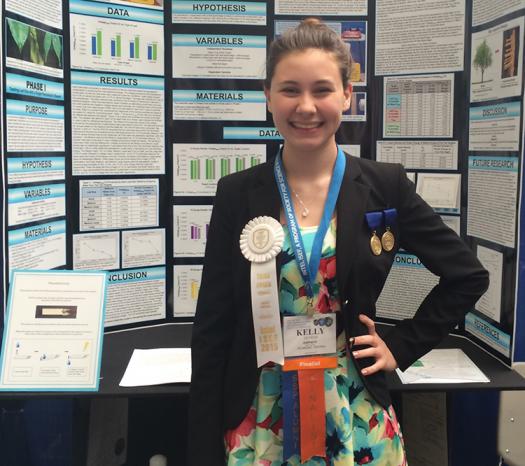
Describe your project which was featured in the magazine.
MARGARET: From the beginning, I knew I wanted to research in the field of biomedical engineering, specifically with an application for tumor treatment. For me, the applications of my potential research are what motivate me to work hard in the lab. I discovered that iron nanoparticles could be used for targeted drug delivery. I worked to make a device that would utilize this process for the treatment of tumors. I’ve decided to continue working with iron nanoparticles, researching the ability of nanoparticles to remove plaque buildup in clogged arteries. The hardest part was finding a way to monitor drug release as the transporter dissolves. To accomplish this, I used doxorubicin, which is a common fluorescent drug used in chemotherapy. I monitored increasing concentrations of doxorubicin in my solution to determine the rate at which the drug was releasing from the delivery device.
ASHWIN: I came up with the original idea in July 2014. I travelled to CalTech/Jet Propulsion Laboratory in Pasadena, California with my school’s astronomy club through the NITARP program, which gives high school teachers and a few of their students the opportunity to conduct real, novel astronomical research with an astronomer from CalTech. While we toured JPL, we saw a life-sized model of the Curiosity Martian rover. The rover had calibration targets, which are needed because when red, charged Martian dust sticks to the rover’s optics, it uses the color targets to try to compensate for the color difference. But that, unfortunately, doesn’t improve the quality of the image. So I thought, “Why fix the symptoms of the dust problem (discoloration, quality reduction), when you could just remove the dust problem in the first place?” I did more research on the Martian dust. “Cops” gave me the idea of using a stun gun as my power source. I was trying to create my own by reversing transformers from charging cables, with little success. Using a $5 stun gun, my apparatus demonstrated promising results. I am currently working on contacting engineers in NASA. Ultimately, I would have to either work with NASA on incorporating my invention into the rover or explore the private aerospace sector.
KELLY: After I developed my idea of constructing a piezoelectric crystal device, I looked to nature for inspiration. I realized that tree branches swaying in the wind closely resemble the vibration and movement that the piezoelectric crystals need to produce electricity. I then worked to create a “tree” of PVC pipe and piezoelectric crystals that used water as a source of kinetic energy. When I was conducting preliminary investigations on my piezoelectric beams, I realized that the water was pooling on the surface, which decreased the efficiency of the beams. I then studied rain forest leaves that use a “drip tip” to remove water from the surface in order to avoid damage. I based my design for the 3D-printed leaf appendages on these leaves and they worked very well at guiding the water off the piezoelectric crystals. This technology could be used in a wide variety of locations to produce clean energy. The “trees” could be easily integrated into a downspout in buildings, with minor infrastructure alterations. This system uses a reservoir to allow a concentrated flow of water and the water is neither consumed nor contaminated in this process. It could also be used in wastewater treatment facilities where there is a constant flow of water to supply the crystals with the kinetic energy needed to create electricity. Because of the self-contained design I’ve developed, they could be used in third-world countries as long as there is sufficient rainfall or runoff in the area. There was a lot of trial and error through this process. I was working with materials that I’d never used before and some of the equipment was very confusing. I went through many different drafts of my tree design until I finally came up with one that I think works very well.
MIHIR: Years ago, my family returned from a vacation to India to find our house filled with fruit flies. We’d forgotten to throw out bananas on the kitchen counter. I spent the next month constantly swatting and missing, but I couldn’t help but wonder about what must be going on “under the hood” — what these flies must be doing to escape so quickly and effectively. I researched and found that the fruit fly’s escape was fairly sophisticated, using their simple but fast visual system. Around the same time, I had been reading about drones in the news. I realized that one of the things preventing them from being used for humanitarian tasks like emergency response was that they weren’t able to respond to changes in their environment. I made the connection to the fruit fly’s escape and built FlyBot, a tiny flying robot that can avoid obstacles (like collapsing ceilings or falling objects) by mimicking the way fruit flies detect and respond to threats. Over millions of years, nature developed incredibly robust and effective solutions through a sort of “trial and error,” so current behaviors and designs are the best that nature has ever tried. Drones, in particular, operate in the same environments as flying organisms — environments that are complex, dynamic, and unknown beforehand — so nature’s designs are a great resource for creating this type of technology.
I’ve extended my work to look at other problems flying robots face and find how to draw inspiration from biology to solve them. One of these problems is obstacle avoidance, making a map of your environment so that you can avoid static obstacles like tables, walls, and chairs. This is typically done with complex sensors like laser scanners, but these sensors are large, heavy, expensive, and draw a lot of power. Instead, my robot uses a single camera to create a map of its environment and draws from the fruit fly, which perceive the environment in terms of edges, and birds, which use each eye independently to create depth. Birds have to solve this problem of converting a series of two-dimensional images into a three-dimensional map of their surroundings. I also explored autonomously locating a target (like a trapped victim after a disaster or in a fire) by combining information from multiple types of sensors. Fruit flies and bacteria are good models for this task since they use simple but effective methods of finding food. I created a proof-of-concept robot that replicates their behaviors to find fires. I conducted real-world testing with a group of local firefighters with small, controlled fires and my robot located them.
DEENA: I knew I wanted to study something that affects many people and doesn’t have enough attention. Uncontrolled bleeding satisfies both. It is unfortunately a deadly phenomenon and the leading cause of death on the battlefield and the second leading cause of death in hospitals and veterinary clinics. The current standard of care for excessive bleeding is inefficient. The most important part of research to me is that my work has an impact. Achieving impact is not so easy. It is a long process that begins with patenting your work. Sometimes, the most challenging thing is waiting and wading through all the legalities of commercialization. For the scientist, what the product can do for people is infinitely more important than a trademark. You have to remember that it is a process that needs to be followed carefully to ensure that your product reaches its final stage in its most effective and cost efficient form.
MAYA: I have been fascinated with microcontrollers from a young age. I started working with my first Arduino board in sixth grade. When I was in eighth grade, I created a novel and cost-effective foot neuropathy analyzer to enable early detection of neuropathy in diabetic patients. This project won the grand prize at the California State Science Fair, among many other awards. The success of that project made me realize that it is possible to develop cheap devices that can replace some of the expensive diagnostic equipment currently used in medicine. I came up with the idea for this pulmonary function analyzer two years ago when one of my close friends had an asthma attack and was taken to the hospital. She later told me that the doctors used a spirometer to check her lung function. My research on lung function testing exposed me to the plight of millions in the world who have untreated respiratory diseases due to the high cost of diagnostic equipment. A cheap lung analysis machine can potentially avoid a large number of deaths due to respiratory diseases.
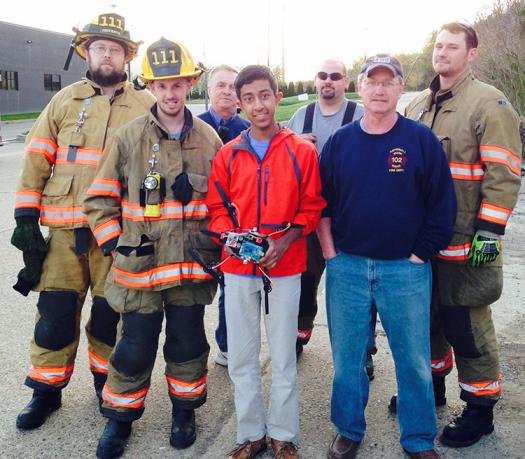
What was your most memorable experience at the Society educational program you attended?
MARGARET: The highlight of my experience at Intel ISEF 2015 was definitely the pin exchange. Before this trip, I had never encountered a blend of so many different cultures in one room and was completely awestruck. The pin exchange helped me realize students’ widespread passion for STEM, which transcends borders between countries and continents. I was able to not only take home many cultural mementos, but to develop an international perspective.
ASHWIN: Intel ISEF 2015 was just stellar, so it is difficult for me to choose my most memorable experience there. The reason I go to science fairs is so I can talk to industry professionals (judges) about my work and get their feedback. I find sharing my work with them to be very enjoyable. Each competitor got many judges with diverse backgrounds. My other favorite experience was the pin exchange on the first night. Meeting other students who are also interested in STEM was fun and exciting.
KELLY: I participated in both Intel ISEF 2014 and Intel ISEF 2015. These competitions were some of the most exciting and unforgettable experiences of my life. I loved all of it, from having a night at Universal Studios, to listening to a panel of Nobel Laureates, but I have to say my favorite part was walking onstage to receive my awards.
MIHIR: One of the coolest things at Broadcom MASTERS was visiting the White House. We had the chance to discuss our projects with staff in the Office of Science and Technology Policy and we spoke with the President’s Chief Scientific Advisor, Dr. Holdren, about how he promotes STEM education. We also had the once-in-a-lifetime opportunity to meet President Obama! He shook each of our hands, took photos, and then gave us a tour of the Oval Office — he showed us the famous patents and models that decorated the walls and bookshelves.
DENNA: My favorite Intel ISEF memory was walking into the main hall for the very first time on set up day. It was one of the most jaw-dropping scenes I have ever witnessed. Rows upon rows of student scientists and their projects, from the U.S., France, Pakistan, or Ghana, studying robots, algorithms, or developing cures for diseases. I remember floating from one booth to another that day, badgering my peers about their work. I basically had to be pried away for judging time.
MAYA: I enjoyed having the opportunity to share my research with professionals in the field. Broadcom MASTERS was a great experience that motivated me to continue my research.

Can you provide a short description of your Society research project?
MARGARET: I synthesized a water-soluble cornstarch/PVA biopolymer embedded with iron nanoparticles to create a drug delivery device. The device is capable of targeted delivery through external magnetic fields, allowing it to be positioned at the site of the tumor. It is also capable of extended drug delivery by slowly releasing drugs as it dissolves. While the transporter was primarily geared toward cancer treatment, it can be used for other diseases that are confined to specific regions of the body. The device is also completely biocompatible.
ASHWIN: My project involved developing an apparatus which uses electrostatic force to remotely clear dust from Mars rover optics, instruments, solar panels, and any other surface.
KELLY: This project investigated using piezoelectric crystal beams to create electricity from rainwater. Piezoelectric crystals convert the energy of movement into electricity. A tree was constructed with branches of piezoelectric crystals attached to PVC pipe. When water drops strike the branch tips, they bend and create energy. A 3D-printed leaf was designed and added to the beams, which increased their efficiency. These trees can be used in many locations and create a viable source of sustainable, clean energy.
MIHIR: For Broadcom MASTERS, I created a way to embed smells within movie clips. During our weekly FaceTime calls, my grandparents in India would show me the garden in front of their house — but I felt like something was missing because I wasn’t able to smell it. I wanted to find a way to digitally recreate smells to make experiences like this richer, so I created a device that uses five modified air fresheners connected to some circuitry that I designed to disperse scents on demand. I also wrote a software library to create and send instructions to those air fresheners and created a movie editor to allow scents to be inserted at various points in a movie clip, with specific duration and strength.
OLIVIA: I invented the Ebola Assay Card (EAC) which uses sandwich ELISA chemistry and applies it to lateral flow technology. This creates a portable, sustainable, rapid, inexpensive, and temperature independent test for Ebola that indicates a positive result through color change. EAC is composed of paper and small amounts of chemicals and silk, doesn’t require refrigeration, and indicates whether the antigen is present in less than 30 minutes. The most challenging aspect was acquiring an Ebola-specific ELISA kit and determining which type of paper would work best for the construction of the channels themselves. I ended up using photo paper and filter paper. I’m currently trying to publish my research and developing EAC for field trials.
DEENA: My project, “Stop the Bleeding! Discovery of a Novel Hemostatic Agent,” aims to find and optimize a composition that can clot a bleeding wound as quickly as possible. Hemostat V-Seal clots wounds in five seconds as opposed to seven minutes for the current standard of care. It can also be applied topically, as opposed to being injected, and can be formulated as a liquid or gel for convenience. Hemostat V-Seal uses components found naturally in the human body that are used directly in the formation of clots.
MAYA: In seventh grade, I created an invention that improves safety at traffic intersections by alerting distracted drivers about an impending change in the state of the traffic signal from green to red, allowing them to plan ahead and stop safely. On May 19, this invention was granted U.S. Patent 9035797. In eighth grade, I created a low-cost pressure measurement and analysis system for diagnosis of diabetic neuropathy, which a patient can use at home to measure his or her foot pressure. This project won the grand prize at the California State Science Fair in 2012.
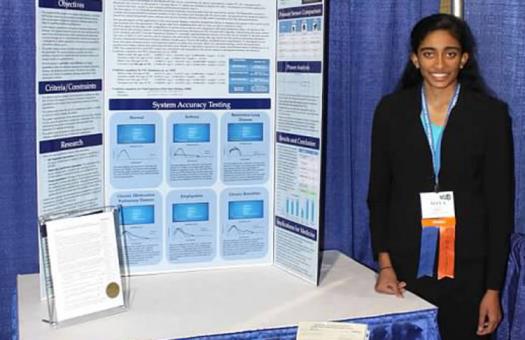
Has your involvement in Society educational programs influenced you to pursue STEM or promote STEM to others?
MARGARET: Intel ISEF has definitely motivated me to pursue STEM. Seeing people from all over the world completely dedicated to science was inspiring. I realized how many students are interested in making a difference not just in their communities, but on a global scale; this encouraged me to do the same.
ASHWIN: From an early age I was fascinated by technology, so I knew that was what I wanted to pursue. But Intel ISEF solidified my belief in myself as a budding inventor/engineer. As for promoting STEM, ISEF has played a part in that. At my school, I strongly advocate for other students to involve themselves in STEM projects, and I seek to mentor any students who want help. I gave a TEDxYouth talk on project-based learning in schools on November 14 in Portland, Oregon.
KELLY: One of the main reasons I loved Intel ISEF was the amount of incredible innovation and creativity that exists at the competition, especially in such young people. I loved being able to walk around the hall and ask a fellow competitor about his or her project, followed by being blown away by the person’s talent and the impressiveness of the research. I am motivated by my fellow peers and they inspire me to make a difference through STEM. For a long time, I debated whether I wanted to pursue engineering or the performing arts, as I love musical theatre. However, my experiences at ISEF confirmed that I would like to pursue a STEM field and gave me confidence that I will succeed. I particularly enjoyed the open house at ISEF when school children from around the area come to the exhibition hall. This sort of community outreach is fantastic and I hope that through this, some boys and girls will be inspired to also engage in STEM.
MIHIR: Broadcom MASTERS was the first time I had participated in a national science fair, and the Broadcom and Society teams went out of their way to make the event really special. One thing that I particularly liked about Broadcom MASTERS was that it exposed me to so many fields of science; seeing the other finalists’ projects and taking part in the STEM challenges showed me that science is incredibly broad and touches virtually every area of our lives. Broadcom MASTERS also showed me that science and engineering — things I had previously been doing as a hobby — could be incredibly fun and useful, and inspired me to keep working on these projects to make a difference.
OLIVIA: I’m still researching and my goal is to have the Ebola Assay Card used in the field as a diagnostic device to save lives through early diagnosis and medical intervention. My experience at Intel ISEF was wonderful I’ve enjoyed the opportunities to speak about my research with younger children and encourage them to pursue STEM.
DEENA: Because I had such a great experience at Intel ISEF, it reaffirmed my interest in pursuing science as a career and joining that amazing global network that I got to be a part of during ISEF. It has encouraged me to view science, even more, as a collaborative process and to encourage others to get involved and add to our collective knowledge. This past summer I was involved in MIT’s Fabrication Laboratory in Giza, Egypt. There, I led a Maker Camp for students that taught an interdisciplinary approach to engineering, covering everything from how to use 3D printers to coding languages. The ultimate goal was to provide students with the knowledge and access to materials they needed to build anything they could imagine. I am currently continuing my 2015 Intel ISEF project by trying to make Hemostat V-Seal commercially available and accessible to hospitals and veterinary clinics.
MAYA: My involvement in Broadcom MASTERS and Intel ISEF helped me to realize the true impact of STEM on the world. Inventions and innovations in STEM are helping to revolutionize healthcare, transportation, the environment, and ultimately, the future of our planet. This has definitely inspired me to promote STEM to others through volunteering at various organizations.
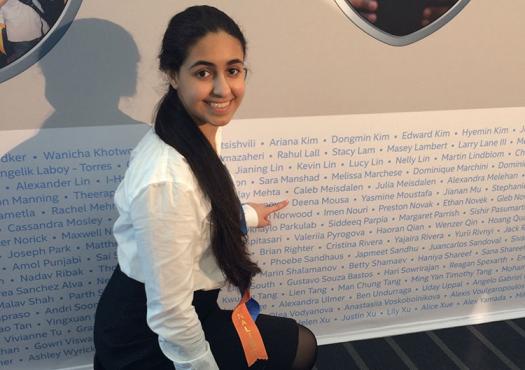
What is your advice to young people interested in science and math?
MARGARET: My advice would be to continue fostering this interest through high school and college, and to never give up. Science and math can be very difficult subjects that often dissuade people from pursuing majors in STEM. Too often, high school students lose interest in STEM because the subject matter is so complex; however, by remaining committed to these disciplines, students may not only rediscover a love for science, but will also be capable of helping their communities and accrue valuable skills. The world is in desperate need of scientists and engineers who will only exist if students are encouraged at every step.
ASHWIN: Don’t stop dreaming. If you have an idea, even if it sounds crazy, don’t limit yourself to the textbook. Get hands-on! Projects of your own design are the most fascinating and will help you develop yourself as a scientist, engineer, or innovator. Seek resources from others if you can’t access them by yourself (the science closets of public schools like my own surprisingly hold plenty of useful things to tinker with). And get your friends involved! Whether you want to enter competitions or not, you and your friends can gain a lot from STEM projects while having a fun time doing them.
KELLY: It’s awesome. Don’t be afraid to explore new territory. You will find things that intrigue, challenge, and inspire you and you’ll quickly be on your way to becoming a science nerd. Embrace this! Being a nerd is awesome and it shows that you are interested and invested in the technologies that are making the world great. Science and math is intriguing, ever-changing, and you can make real impacts through these fields. A lot of people may think that science fairs are lame or boring, but this couldn’t be more wrong. Some of the most fun I’ve had has been through science fair competitions. Also, just because you may be interested in science and math doesn’t mean you can’t have other creative interests. I love musical theatre, singing, tap dancing, playing the guitar and piano, and painting. I believe that my technical and creative sides help me in my pursuits of both STEM and the performing arts.
MIHIR: Look around. There are so many problems in the world — so pick a problem that excites you. There are so many solutions that exist in places where you might not expect, or where scientists might not have looked before — I never expected fruit flies to hold the key to designing better drones — and curiosity will allow you to make these kinds of unlikely connections.
OLIVIA: Science and math are powerful platforms for innovation. Find a topic that you feel passionate about and pursue it. Everyone has a role in change.
DEENA: Always ask questions. Some of the best discoveries start with just taking a moment to ask “Why?” To me, that child-like curiosity is extremely central to science. It is what binds scientists together.
MAYA: My advice to young people interested in science and math would be to never fear failure. Sometimes, the best ideas and innovations result from mistakes, so it is always important to keep persevering.


